What does it take to become special, a champion, one of the greats of all time? Breaking barriers of sex, race, and physical disabilities are key criteria. These seven women are archetypal greats. Reading about them is inspiring and humbling. Pioneers, all of them. They did what no one before them had done. Here’s my small tribute on this day of all days.
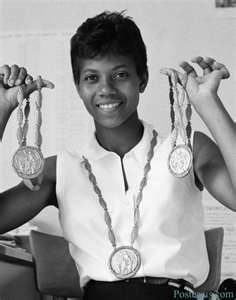
Althea Gibson crossed both color and sports lines. She was a champion tennis player and a champion golfer. From Wiki:
“Althea Gibson (August 25, 1927 – September 28, 2003) was an American tennis player and professional golfer, and the first black athlete to cross the color line of international tennis. In 1956, she became the first person of color to win a Grand Slam title (the French Open). The following year she won both Wimbledon and the U.S. Nationals (precursor of the U.S. Open), then won both again in 1958, and was voted Female Athlete of the Year by the Associated Press in both years. In all, she won 11 Grand Slam tournaments, including six doubles titles, and was inducted into the International Tennis Hall of Fame and the International Women’s Sports Hall of Fame. “She is one of the greatest players who ever lived,” said Robert Ryland, a tennis contemporary and former coach of Venus and Serena Williams. “Martina couldn’t touch her. I think she’d beat the Williams sisters.”[1] In the early 1960s she also became the first black player to compete on the women’s professional golf tour.
At a time when racism and prejudice were widespread in sports and in society, Gibson was often compared to Jackie Robinson. “Her road to success was a challenging one,” said Billie Jean King, “but I never saw her back down.”
“To anyone, she was an inspiration, because of what she was able to do at a time when it was enormously difficult to play tennis at all if you were black,” said former New York City Mayor David Dinkins. “I am honored to have followed in such great footsteps,” wrote Venus Williams. “Her accomplishments set the stage for my success, and through players like myself and Serena and many others to come, her legacy will live on.”
GOLF:
In 1964, at the age of 37, Gibson became the first African-American woman to join the Ladies Professional Golf Association (LPGA) tour.[64] Racial discrimination continued to be a problem: Many hotels still excluded people of color, and country club officials throughout the south—and some in the north—routinely refused to allow her to compete. When she did compete, she was often forced to dress for tournaments in her car because she was banned from the clubhouse.[65] Although she was one of the LPGA’s top 50 money winners for five years, and won a car at a Dinah Shore tournament, her lifetime golf earnings never exceeded $25,000.[66] She made financial ends meet with various sponsorship deals and the support of her husband, William Darben, brother of best friend and fellow tennis player Rosemary Darben, whom she married in 1965 (and divorced in 1976).[67]
While she broke course records during individual rounds in several tournaments, Gibson’s highest ranking was 27th in 1966, and her best tournament finish was a tie for second after a three-way playoff at the 1970 Len Immke Buick Open.[68] She retired from professional golf at the end of the 1978 season.[69] “Althea might have been a real player of consequence had she started when she was young,” said Judy Rankin. “She came along during a difficult time in golf, gained the support of a lot of people, and quietly made a difference.”[70]
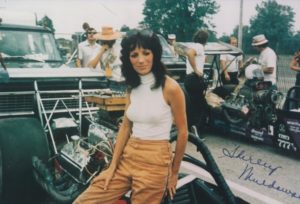
What, do you think, would be the sport most resistant to competition against men? Try drag racing. I give you Shirley “Cha Cha” Muldowney. From Wiki:
“Shirley Muldowney (born June 19, 1940[1]), also known professionally as “Cha Cha” and the “First Lady of Drag Racing”, is an American auto racer. She was the first woman to receive a license from the National Hot Rod Association (NHRA) to drive a Top Fuel dragster. She won the NHRA Top Fuel championship in 1977, 1980, and 1982, becoming the first person to win two and three Top Fuel titles.[2][3] She won a total of 18 NHRA national events.
Born Shirley Ann Roque in Burlington, Vermont, Muldowney began street racing in the 1950s in Schenectady, New York. “School had no appeal to me. All I wanted was to race up and down the streets in a hot rod,” declared Muldowney.[3] When she was 16, she married 19-year-old Jack Muldowney,[4] who would build her first dragster…
In 1958, Muldowney made her debut on the dragstrip of the Fonda Speedway. She obtained her NHRA pro license in 1965. She competed in the 1969 and 1970 U.S. Nationals in a twin-engine dragster in Top Gas.[2][6] With Top Gas losing popularity, Muldowney switched to Funny Car, buying her first car from Connie Kalitta…
Muldowney won her first major event, the International Hot Rod Association (IHRA) Southern Nationals, in 1971.
She stepped up to Top Fuel, getting her license in 1973. From 1973 to 1977, she teamed up with Connie Kalitta as the Bounty Hunter and Bounty Huntress in match races, in a pair of Ford Mustangs, hers a Buttera chassis, his a Logghe. The Bounty Huntress Mustang caught fire at Dragway 42 in Ohio in 1973.
An unprecedented three NHRA Top Fuel Dragster world championships followed, in 1977, 1980, and 1982.
Muldowney success met enormous opposition from those who felt drag racing (or any form of motorsport, for that matter) was no place for women. Don Garlits [Big Daddy, the King of Drag Racing] has said about her:
“Now, if you ask who do I have the most respect for, I’d say Shirley Muldowney. She went against all odds. They didn’t want her to race Top Fuel, the association, the racers, nobody…Just Shirley.”
Muldowney noted, “NHRA fought me every inch of the way, but when they saw how a girl could fill the stands; they saw I was good for the sport.”[9]
A crash in 1984 crushed her hands, pelvis, and legs, necessitating half a dozen operations and 18 months of therapy.[3] Muldowney was sidelined for a long period, but returned to the circuit in the late 1980s. She continued to race, mostly without major sponsorship, throughout the 1990s in IHRA competition as well as match-racing events. She returned to the NHRA towards the end of her career, running select events until her retirement at the end of 2003.”
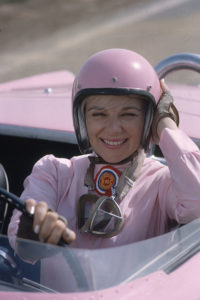
Here’s the one of these great ladies I got to see in person. Saw her race at the Vineland NJ Speedway when I was a boy. We all rooted for her. She was a star. From Wiki:
“Donna Mae Mims (July 1, 1927–October 6, 2009) was an American race car driver. She was the first woman to win a Sports Car Club of America (SCCA) national championship. Mims won the SCCA Class H championship in 1963. She was known as the “Pink Lady” of racing because she wore a pink racing helmet and coveralls and had the phrase “Think Pink” emblazoned on the back of her pink racing cars. Mims also competed in the fourth (and last) running of the Cannonball Run race in March 1979.
She and her husband purchased a fuel-injected Corvette and developed an interest in automobile racing. The Yenko dealership had a division involved in automobile racing, and in 1960, Mims started racing cars with friends from Yenko. She quickly became one of the top amateur race car drivers in the country.[1] She won her first race in 1960, driving her Corvette at the B Production race at the Cumberland National.[2]
Mims became a regular participant in the Cumberland National Sports Car Classic in the 1960s. She finished second to Frank Nagle of Wyomissing, Pennsylvania, in the Lions Club Trophy race at the Cumberland Municipal Airport in 1963.[3]
In 1963, Mims won the Sports Car Club of America national racing championship driving a pink Austin-Healey 1959 Bugeye Sprite that once had belonged to Dr. Jonas Salk.[1] She won the 1963 Class H championship after competing in ten sanctioned races in her Austin Healey Sprite. She placed first in two of the ten races, placed second three times.[4] In the twenty-year history of the Sports Car Club of America to that point, Mims was the first woman to win a national racing championship.[4][5][6]
Mims became known as the “Pink Lady”, because most of the automobiles in which she raced were painted pink. Her cars included the pink Austin-Healey in which she won the championship and a pink Corvette, Corvair, Triumph TR3 and MGB.[1] In 2009, Mims told the Pittsburgh Post-Gazette, “On the back of most of my cars I had ‘Think Pink’ … I liked pink ever since I was a little girl.” In 1964, the UPI ran a feature story on Mims, noting that the “Pink Lady” not only drove a pink car, but wore a pink helmet and pink coveralls. The feature story continued:
“It’s easy to see why men chase after Donna Mae Mims. She’s a delightful blonde with an intriguing smile, well-shaped figure and a laughing sense of humor. And much like most other members of her sex, she delights in leading men a merry chase. Only trouble is, Donna Mae doesn’t want to get caught. For it’s a double life Donna Mae leads, and when she isn’t sitting at a secretary’s desk she’s pursuing her career as ‘the pink lady of racing.'”[4]
Mims continued to race automobiles for 12 years. In 1969, Los Angeles Times columnist Jack Smith wrote a column about Mims when she visited the Los Angeles auto show. Mims described her pre-race rituals to Smith:
“I psych myself. I remove all my makeup. I think stern. I bristle. I don’t talk to anybody. You cannot think nice. Chivalry is dead on the racetrack. You’re out there only for one thing. To win. Nobody remembers second place.”[6]
She told another reporter, “A lot of the male drivers think I’m out there to prove that I can beat them because they’re men. That isn’t so. They claim that I sometimes charge into the corners, cutting them off. I don’t mean to. I’m just trying to win.”[4]
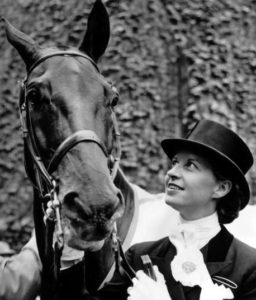
Paralyzed by polo from the knees down, Lis Hartel nevertheless became the first woman to medal at the Olympics in competition against male equestrians. From Wiki:
“Lis Hartel (March 14, 1921 – February 12, 2009) was an equestrian from Denmark. She was originally coached by her mother, Else Holst, but began to be coached by professional horseman Gunnar Andersen when she became nationally competitive.
“She was the Danish dressage champion in 1943 and 1944.[4] In September 1944 at age 23 she contracted polio, which permanently paralyzed her below the knees, as well as affecting her arms and hands.[1][5][4] She was pregnant at the time, but had a healthy daughter.[6] Hartel was determined to continue her equestrian career despite medical advice otherwise, and in 1947 she finished second at the Scandinavian championships, although she had to be helped onto her horse when she rode.[5][7]
“Dressage at the Olympics was open only to commissioned military officers until 1952, and in that year Hartel was one of the first women to compete against men in an equestrian sport at the Olympics.[6] Her silver medal in 1952 for Individual Dressage was the first by any woman in any individual sport when in direct competition with men at the Olympics, and she was also the Danish champion in dressage that year.[3][4] She continued to be Danish champion in dressage in 1953, 1954, 1956 and 1959.[3] In 1956 she also won another silver medal, this time at the 1956 Olympics in Melbourne, Australia (the Equestrian Games of those Olympics were held in Stockholm because of Australian quarantine laws for horses).[3][6][7][8]
“After retiring from competitive riding, Hartel gave demonstrations, raising money for polio sufferers and supporting therapeutic riding for people with disabilities.[5] The Lis Hartel Foundation in the Netherlands, named after her, offers such riding opportunities.[5][3]
“In 1992 Hartel was inducted into Denmark’s Hall of Fame, and in 2005 she was named one of Denmark’s top 10 athletes of all time.”
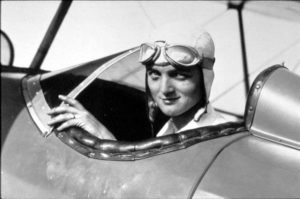
Amelia Earhart was the most famous female aviator of her day. But she wasn’t the best. That honor belonged to Louise Thaden. From Wiki:
Thaden rapidly became a major figure in the aviation world and set many world performance records and won many major flying events. In 1929, she became the first pilot to hold the women’s altitude, endurance and speed records in light planes simultaneously. Thaden set the women’s altitude record in December 1928 with a mark of 20,260 feet. In March 1929, she set the women’s endurance record with a flight of 22 hours, 3 minutes, 12 seconds.
Women were barred from air racing from 1930 to 1935, due to sexism.[2]
Women’s Air Derby
Thaden was a friend and rival of pioneer aviators Amelia Earhart, Pancho Barnes, Opal Kunz, and Blanche Noyes. Thaden defeated her colleagues [easily] in the first Women’s Air Derby, also known as the Powder Puff Derby, in 1929. The Air Derby was a transcontinental race from Santa Monica, California to Cleveland, Ohio, which was the site of the National Air Races that year. It took place from August 13–20, 1929. Twenty women were entered in the race. Marvel Crosson was killed. Earhart damaged her aircraft at Yuma, Arizona, Barnes became lost and flew into Mexico and damaged her plane attempting to get back on course, and Noyes suffered an in-flight fire over Texas.[3]
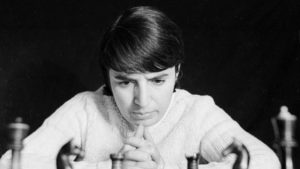
If they’ll let you, you can beat the men at their own game. I give you Nona. From Wiki:
“Nona Gaprindashvili (Georgian: ნონა გაფრინდაშვილი; born 3 May 1941) is a Georgian chess player, the sixth women’s world chess champion (1962–1978), and first female Grandmaster. Born in Zugdidi, Georgia (then part of the Soviet Union), she is the strongest female player of her generation.
“In 1961, aged 20, Gaprindashvili won the fourth women’s Candidates Tournament, setting up a title match against Russian world champion Elisabeth Bykova. She won the match easily, with a final score of 9-2 (+7−0=4), and went on to defend her title successfully four times: three times against Alla Kushnir (1965: 10–6; 1969: 12–7; 1972: 12–11) and once against fellow Georgian Nana Alexandria (1975: 9–4). She finally lost her crown in 1978 to another Georgian, 17-year-old Maia Chiburdanidze, by a score of 6½–8½ (+2−4=9).
“Gaprindashvili played for the Soviet Union in the Chess Olympiads of 1963, 1966, 1969, 1972, 1974, 1978, 1980, 1982, 1984, 1986, 1990, and for Georgia in 1992.[1] She was one of the contributing players of the USSR team that dominated the women’s Olympiads of the 1980s. She won as many as 25 medals, among which 11 team gold medals and 9 individual gold medals.[2] At the Olympiad of Dubai 1986 she won all the ten games she played.
“She was a five-times winner of the Women’s Soviet Championship: in 1964, 1973, 1981, 1983, and 1985.
“During her career Gaprindashvili successfully competed in men’s tournaments, winning (amongst others) the Hastings Challengers tournament in 1963/4 and tying for first place at Lone Pine International tournament in 1977.
“In 1978 Gaprindashvili became the first woman to be awarded the Grandmaster title. She was awarded the title after scoring two grandmaster norms totaling 23 games, the last of which was winning Lone Pine 1977 against a field of 45 players, mostly grandmasters. Although the GM title normally required 24 games, by exceeding the GM ‘norm’ requirement in Lone Pine, FIDE found her results over 23 games equivalent to 24 games and made her the first woman Grandmaster.”
***************************
Don’t know how to close this, except to say I am full of admiration for all seven of them. I imagine you are too.
















